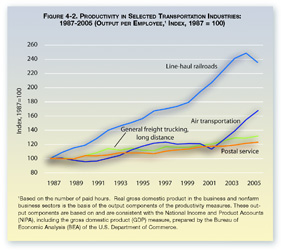Figure 4-2. Productivity in Selected Transportation Industries: 1987-2005 (Output per Employee,1 Index, 1987 = 100)
In general, moving goods is cheaper now than in the past. Productivity has improved in both long-distance railroading and long-distance trucking over the past decade but much more quickly in rail than road transportation. Between 1987 and 2005, output-per-hour worked more than doubled in line-haul railroading but grew only 37 percent in long-distance, general-freight trucking. Line-haul railroads primarily engage in operating railroads for the transport of passengers and/or cargo over a long distance within a rail network. These establishments do not include switching and terminal operations or short-distance (or local) railroads. Long-distance, general-freight trucking establishments are operations other than those primarily engaged in local trucking and specialized trucking. Specialized trucking establishments are engaged in the transportation of freight that, because of size, weight, shape, or other inherent characteristics, requires specialized equipment, such as flatbeds, tankers, or refrigerated trailers.

Data represented in the figure
Table in Excel format | Historical data
| 1987 | 1988 | 1989 | 1990 | 1991 | 1992 | 1993 | 1994 | 1995 | 1996 | 1997 | 1998 | 1999 | 2000 | 2001 | 2002 | 2003 | 2004 | 2005 | ||
|---|---|---|---|---|---|---|---|---|---|---|---|---|---|---|---|---|---|---|---|---|
| Output per hour worked | ||||||||||||||||||||
| Air transportation | 100 | 101 | 98 | 96 | 96 | 100 | 104 | 112 | 118 | 122 | 123 | 120 | 121 | 121 | 113 | 126 | 139 | 155 | 167 | |
| Line-haul railroads | 100 | 108 | 115 | 119 | 128 | 140 | 145 | 150 | 156 | 167 | 170 | 173 | 179 | 194 | 207 | 224 | 241 | 248 | 235 | |
| General freight trucking, long-distance | 100 | 101 | 100 | 104 | 108 | 114 | 112 | 115 | 112 | 111 | 117 | 116 | 116 | 119 | 120 | 125 | 129 | (R) 129 | 131 | |
| Postal Service | 100 | 99 | 99 | 104 | 103 | 105 | 108 | 108 | 108 | 106 | 110 | 112 | 113 | 116 | 117 | 117 | 119 | 121 | 122 | |
Key: R = revised.
1Based on the number of paid hours. Real gross domestic product in the business and nonfarm business sectors is the basis of the output components of the productivity measures. These output components are based on and are consistent with the National Income and Product Accounts (NIPA), including the gross domestic product (GDP) measure, prepared by the Bureau of Economic Analysis (BEA) of the U.S. Department of Commerce.
Source: U.S. Department of Labor, Bureau of Labor Statistics, Industry Productivity, available at http://www.bls.gov/ as of June 12, 2007
You will need the Adobe Acrobat Reader to view the PDFs on this page.
To view Excel files, you can use the Microsoft Excel Viewer.